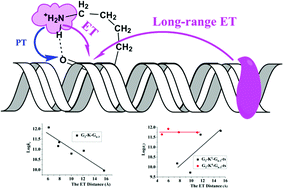Modulation of proton-coupled electron transfer reactions in lysine-containing alpha-helixes: alpha-helixes promoting long-range electron transfer†
Abstract
The proton-coupled electron transfer (PCET) reaction plays an important role in promoting many biological and chemical reactions. Usually, the rate of the PCET reaction increases with an increase in the electron transfer distance because long-range electron transfer requires more free energy barriers. Our density functional theory calculations here reveal that the mechanism of PCET occurring in lysine-containing alpha(α)-helixes changes with an increasing number of residues in the α-helical structure and the different conformations because of the modulation of the excess electron distribution by the α-helical structures. The rate constants of the corresponding PCET reactions are independent of or substantially shallower dependent on the electron transfer distances along α-helixes. This counter-intuitive behavior can be attributed to the fact that the formation of larger macro-cylindrical dipole moments in longer helixes can promote electron transfer along the α-helix with a low energy barrier. These findings may be useful to gain insights into long-range electron transfer in proteins and design α-helix-based electronics via the regulation of short-range proton transfer.



 Please wait while we load your content...
Please wait while we load your content...